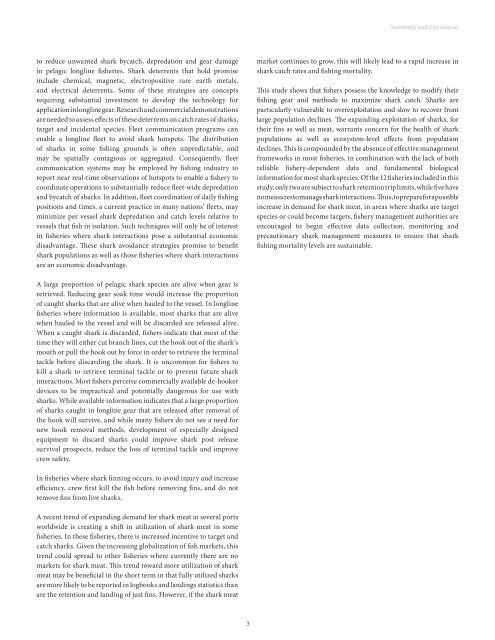Shark Depredation and Unwanted Bycatch in Pelagic Longline
Shark Depredation and Unwanted Bycatch in Pelagic Longline
Shark Depredation and Unwanted Bycatch in Pelagic Longline
Create successful ePaper yourself
Turn your PDF publications into a flip-book with our unique Google optimized e-Paper software.
Summary <strong>and</strong> Conclusion<br />
to reduce unwanted shark bycatch, depredation <strong>and</strong> gear damage<br />
<strong>in</strong> pelagic longl<strong>in</strong>e fisheries. <strong>Shark</strong> deterrents that hold promise<br />
<strong>in</strong>clude chemical, magnetic, electropositive rare earth metals,<br />
<strong>and</strong> electrical deterrents. Some of these strategies are concepts<br />
requir<strong>in</strong>g substantial <strong>in</strong>vestment to develop the technology for<br />
application <strong>in</strong> longl<strong>in</strong>e gear. Research <strong>and</strong> commercial demonstrations<br />
are needed to assess effects of these deterrents on catch rates of sharks,<br />
target <strong>and</strong> <strong>in</strong>cidental species. Fleet communication programs can<br />
enable a longl<strong>in</strong>e fleet to avoid shark hotspots. The distribution<br />
of sharks <strong>in</strong> some fish<strong>in</strong>g grounds is often unpredictable, <strong>and</strong><br />
may be spatially contagious or aggregated. Consequently, fleet<br />
communication systems may be employed by fish<strong>in</strong>g <strong>in</strong>dustry to<br />
report near real-time observations of hotspots to enable a fishery to<br />
coord<strong>in</strong>ate operations to substantially reduce fleet-wide depredation<br />
<strong>and</strong> bycatch of sharks. In addition, fleet coord<strong>in</strong>ation of daily fish<strong>in</strong>g<br />
positions <strong>and</strong> times, a current practice <strong>in</strong> many nations’ fleets, may<br />
m<strong>in</strong>imize per vessel shark depredation <strong>and</strong> catch levels relative to<br />
vessels that fish <strong>in</strong> isolation. Such techniques will only be of <strong>in</strong>terest<br />
<strong>in</strong> fisheries where shark <strong>in</strong>teractions pose a substantial economic<br />
disadvantage. These shark avoidance strategies promise to benefit<br />
shark populations as well as those fisheries where shark <strong>in</strong>teractions<br />
are an economic disadvantage.<br />
market cont<strong>in</strong>ues to grow, this will likely lead to a rapid <strong>in</strong>crease <strong>in</strong><br />
shark catch rates <strong>and</strong> fish<strong>in</strong>g mortality.<br />
This study shows that fishers possess the knowledge to modify their<br />
fish<strong>in</strong>g gear <strong>and</strong> methods to maximize shark catch. <strong>Shark</strong>s are<br />
particularly vulnerable to overexploitation <strong>and</strong> slow to recover from<br />
large population decl<strong>in</strong>es. The exp<strong>and</strong><strong>in</strong>g exploitation of sharks, for<br />
their f<strong>in</strong>s as well as meat, warrants concern for the health of shark<br />
populations as well as ecosystem-level effects from population<br />
decl<strong>in</strong>es. This is compounded by the absence of effective management<br />
frameworks <strong>in</strong> most fisheries, <strong>in</strong> comb<strong>in</strong>ation with the lack of both<br />
reliable fishery-dependent data <strong>and</strong> fundamental biological<br />
<strong>in</strong>formation for most shark species. Of the 12 fisheries <strong>in</strong>cluded <strong>in</strong> this<br />
study, only two are subject to shark retention trip limits, while five have<br />
no measures to manage shark <strong>in</strong>teractions. Thus, to prepare for a possible<br />
<strong>in</strong>crease <strong>in</strong> dem<strong>and</strong> for shark meat, <strong>in</strong> areas where sharks are target<br />
species or could become targets, fishery management authorities are<br />
encouraged to beg<strong>in</strong> effective data collection, monitor<strong>in</strong>g <strong>and</strong><br />
precautionary shark management measures to ensure that shark<br />
fish<strong>in</strong>g mortality levels are susta<strong>in</strong>able.<br />
A large proportion of pelagic shark species are alive when gear is<br />
retrieved. Reduc<strong>in</strong>g gear soak time would <strong>in</strong>crease the proportion<br />
of caught sharks that are alive when hauled to the vessel. In longl<strong>in</strong>e<br />
fisheries where <strong>in</strong>formation is available, most sharks that are alive<br />
when hauled to the vessel <strong>and</strong> will be discarded are released alive.<br />
When a caught shark is discarded, fishers <strong>in</strong>dicate that most of the<br />
time they will either cut branch l<strong>in</strong>es, cut the hook out of the shark’s<br />
mouth or pull the hook out by force <strong>in</strong> order to retrieve the term<strong>in</strong>al<br />
tackle before discard<strong>in</strong>g the shark. It is uncommon for fishers to<br />
kill a shark to retrieve term<strong>in</strong>al tackle or to prevent future shark<br />
<strong>in</strong>teractions. Most fishers perceive commercially available de-hooker<br />
devices to be impractical <strong>and</strong> potentially dangerous for use with<br />
sharks. While available <strong>in</strong>formation <strong>in</strong>dicates that a large proportion<br />
of sharks caught <strong>in</strong> longl<strong>in</strong>e gear that are released after removal of<br />
the hook will survive, <strong>and</strong> while many fishers do not see a need for<br />
new hook removal methods, development of especially designed<br />
equipment to discard sharks could improve shark post release<br />
survival prospects, reduce the loss of term<strong>in</strong>al tackle <strong>and</strong> improve<br />
crew safety.<br />
In fisheries where shark f<strong>in</strong>n<strong>in</strong>g occurs, to avoid <strong>in</strong>jury <strong>and</strong> <strong>in</strong>crease<br />
efficiency, crew first kill the fish before remov<strong>in</strong>g f<strong>in</strong>s, <strong>and</strong> do not<br />
remove f<strong>in</strong>s from live sharks.<br />
A recent trend of exp<strong>and</strong><strong>in</strong>g dem<strong>and</strong> for shark meat at several ports<br />
worldwide is creat<strong>in</strong>g a shift <strong>in</strong> utilization of shark meat <strong>in</strong> some<br />
fisheries. In these fisheries, there is <strong>in</strong>creased <strong>in</strong>centive to target <strong>and</strong><br />
catch sharks. Given the <strong>in</strong>creas<strong>in</strong>g globalization of fish markets, this<br />
trend could spread to other fisheries where currently there are no<br />
markets for shark meat. This trend toward more utilization of shark<br />
meat may be beneficial <strong>in</strong> the short term <strong>in</strong> that fully utilized sharks<br />
are more likely to be reported <strong>in</strong> logbooks <strong>and</strong> l<strong>and</strong><strong>in</strong>gs statistics than<br />
are the retention <strong>and</strong> l<strong>and</strong><strong>in</strong>g of just f<strong>in</strong>s. However, if the shark meat












